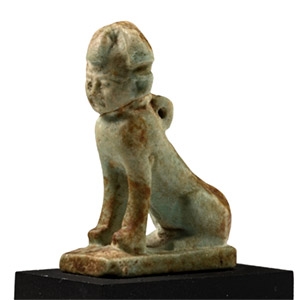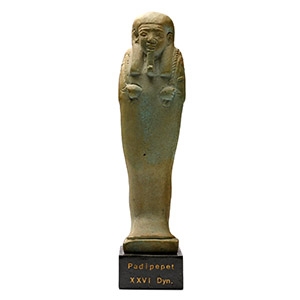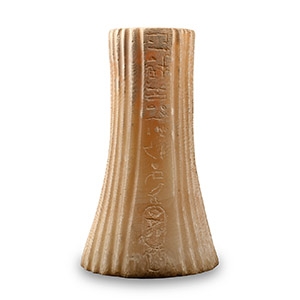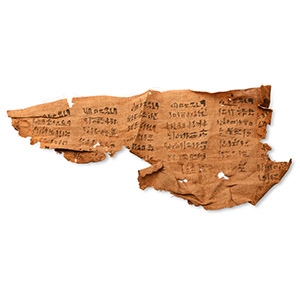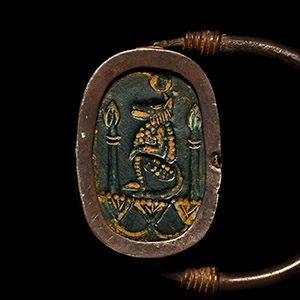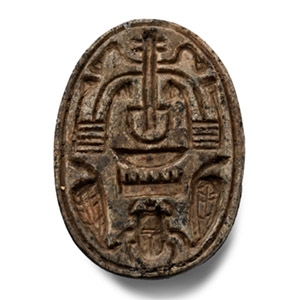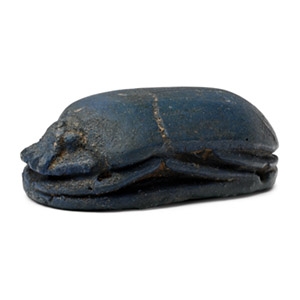Home > Auctions > 9 - 17 September 2025
Ancient Art, Antiquities, Books, Natural History & Coins
From the collection of Mrs Kilvert, who fled from France to England during the French Revolution.
Received by gift to the Hodge family from Mrs Kilvert at Bath in 1864-1865; thence by descent to the grandchildren of Mr John Hodge, a private London tutor.
From the collection of a New Zealand family; thence by descent.
This lot has been checked against the Interpol Database of stolen works of art and is accompanied by a search certificate number no.12845-239091.
This lot has been cleared against the Art Loss Register database, and is accompanied by an illustrated lot declaration signed by the Head of the Antiquities Department, Dr Raffaele D'Amato.
Cf. Schneider, H.D., Shabtis. An Introduction to the History of Ancient Egyptian Funerary Statuettes with a Catalogue of the Collection of Shabtis in the National Museum of Antiquities at Leiden, Vol. 3, Leiden, 1977, p. 12, no. 3.1.1.25, for a shabti of similar style and text arrangement.
From the collection of Mrs Kilvert, who fled from France to England during the French Revolution.
Received by gift to the Hodge family from Mrs Kilvert at Bath in 1864-1865; thence by descent to the grandchildren of Mr John Hodge, a private London tutor.
From the collection of a New Zealand family; thence by descent.
This lot has been checked against the Interpol Database of stolen works of art and is accompanied by a search certificate number no.12846-239090.
This lot has been cleared against the Art Loss Register database, and is accompanied by an illustrated lot declaration signed by the Head of the Antiquities Department, Dr Raffaele D'Amato.
Cf. Janes, G., The Shabti Collections 5: A Selection from the Manchester Museum, Lymm, 2012, p.64, for a shabti with a similar decorative arrangement.
A shabti, also known as ushabti or shawabti, is a small funerary figurine found in ancient Egyptian tombs, dating from around 2000 BCE to 30 BCE. Its main purpose was to serve as a servant for the deceased in the afterlife, carrying out manual tasks such as farming or irrigation. Shabtis were often inscribed with a magical formula from the Book of the Dead to ensure they would animate when summoned. The distinctive, lighter-coloured, and previously part-gilded upper body decoration, contrasting with the black used for the rest of the figure, may symbolise the moment of rebirth, when the face of the deceased was bathed in the sun's rays.
Old private French collection.
Anonymous sale, Beaussant Lefevre, Paris, 2015.
Private European collection, acquired in 2015.
This lot is accompanied by an illustrated lot declaration signed by the Head of the Antiquities Department, Dr Raffaele D'Amato.
Cf. Andrews, C., Amulets of Ancient Egypt, London, 1994, p. 53, fig. 54d, for a similar duck scaraboid; Matouk, F.S., Corpus du scarabée égyptien. Vol. 2: Analyse thématique, Beirut, 1976, p. 388, nos. 814-815, for similar-themed scarabs.
with Charles Ede Ltd, London, UK.
Private collection, London, UK, acquired from the above on 28 April 1994.
Accompanied by a copy of the Charles Ede invoice.
This lot is accompanied by an illustrated lot declaration signed by the Head of the Antiquities Department, Dr Raffaele D'Amato.
Cf. Andrews, C., Amulets of Ancient Egypt, British Museum 1994, p.78, fig.78d, for a similar amulet.
The 'Nubian' hairstyle was worn by young women in connection with birth, nursing babies and applying cosmetics.
Elizabeth Helene Demarest Osten Driesen (1892-1931).
Given as a gift to her granddaughter, Lady Annabel Sutherland, by descent in the late 1960s.
This lot has been checked against the Interpol Database of stolen works of art and is accompanied by search certificate number no.12762-237137.
This lot has been cleared against the Art Loss Register database, and is accompanied by an illustrated lot declaration signed by the Head of the Antiquities Department, Dr Raffaele D'Amato.
Cf. Berlev, O. and Hodjash, S., Catalogue of Monuments of Ancient Egypt: From the Museums of the Russian Federation, Ukraine, Bielorussia, Caucasus, Middle Asia and the Baltic States, Orbis Biblicus et Orientalis 17, Fribourg/Göttingen, 1998, pl. 90 VI.34, for a similar example; Waziry, M., Vestiges of Ancient Egypt: The Bubasteion Votive Cachette at Saqqara, Houston, 2023, p. 68, no. 19, for a recently excavated wooden cat coffin with a bronze head still in place.
In ancient Egypt, the cat was venerated as the sacred animal of the goddess Bastet, whose principal cult centre was Bubastis in the Nile Delta. Although cats were once part of folk practice, their veneration as part of formal cults spread across Egypt during the Late Period. Bastet was closely linked to lion-headed goddesses like Sekhmet, Tefnut, and Pakhet, and the cat itself became associated with solar imagery: the Book of the Dead portrays the sun god as a Great Cat vanquishing Apophis beneath the sacred Ished Tree. The cat could also embody the Eye of the Sun or, more often in Bastet’s case, the Eye of the Moon. Mummified cats were frequently dedicated as votive offerings, and some of their feline-shaped coffins were adorned with finely crafted bronze heads to enhance their divine likeness.
From the private collection of a Canadian gentleman living in Essex, UK, formed since the 1920s-circa 1990.
Property of an Essex lady until the late 1990s; thence by descent.
From the private collection of an Essex gentleman since the late 1990s.
This lot is accompanied by an illustrated lot declaration signed by the Head of the Antiquities Department, Dr Raffaele D'Amato.
Cf. Allen, T.G., A Handbook of the Egyptian Collection, Chicago,1923, p. 72 for another shabti of Padipepet in the Art Institute, Chicago.
A shabti (also known as ushabti or shawabti) is a small funerary figurine found in ancient Egyptian tombs, dating from around 2000 BCE to 30 BCE. Its primary purpose was to serve as a helper for the deceased in the afterlife, performing manual tasks like farming or irrigation. Shabtis were often inscribed with a magical formula from the Book of the Dead to ensure they would come to life when summoned. The relatively short inscription on this example includes the opening and closing parts of the spell.
Private collection of Mr A., Montreal, acquired in the early 1980s.
Private collection, Switzerland, acquired from the above in 1993.
Thence by descent, family collection, from the late 1990s.
This lot has been checked against the Interpol Database of stolen works of art and is accompanied by a search certificate number no.12849-241633.
This lot has been cleared against the Art Loss Register database, and is accompanied by an illustrated lot declaration signed by the Head of the Antiquities Department, Dr Raffaele D'Amato.
Cf. head-rest assembly in the British Museum, accession no.EA30413.
From the private collection of a Canadian gentleman living in Essex, UK, formed since the 1920s-circa 1990.
Property of an Essex lady until the late 1990s; thence by descent.
From the private collection of an Essex gentleman since the late 1990s.
This lot is accompanied by an illustrated lot declaration signed by the Head of the Antiquities Department, Dr Raffaele D'Amato.
Cf. El-Khouli, Egyptian Stone Vessels: Predynastic Period to Dynasty III, London, 1974, vol 1, p. 169 B. u); vol.3, pl. 49, no. 1210, for a similar vessel from Tarkhan.
From the collection of a gentleman, acquired on the London art market in the 1990s.
This lot is accompanied by an illustrated lot declaration signed by the Head of the Antiquities Department, Dr Raffaele D'Amato.
Cf. De Caluwe, A., Un "Livre des Morts" sur bandelette de momie, Brussels, 1991, for a discussion of the longest known inscribed mummy bandage.
From the fifth century B.C., mummy wrappings for the affluent frequently display lines of hieratic script—a cursive variant of Egyptian hieroglyphs used for both daily and religious writings. These often include excerpts from funerary texts like the Book of the Dead, along with prayers and invocations designed to safeguard and guide the deceased in the afterlife. These texts, sometimes accompanied by vignettes, were inscribed directly on the linen strips before or during the mummification process. Some of these bandages could be remarkably long; one example from Brussels, measuring only 6.2 cm in width, spans an incredible 26 metres.
From the late S M collection, London, UK, 1969-1999.
This lot has been cleared against the Art Loss Register database, and is accompanied by an illustrated lot declaration signed by the Head of the Antiquities Department, Dr Raffaele D'Amato.
Cf. Chadour, A.B., Rings. The Alice and Louis Koch Collection, volume I, Leeds, 1994, items 39-42, for type.
From the collection of a gentleman, acquired on the London art market in the 1990s.
This lot is accompanied by an illustrated lot declaration signed by the Head of the Antiquities Department, Dr Raffaele D'Amato.
Cf. Petrie, W.M.F., Button and Design Scarabs, London, 1925, pl. X, no. 383, for a scarab featuring a similarly large and stylised sma design.
Old private French collection.
Anonymous sale, Beaussant Lefevre, Paris, 2015.
Private European collection, 2015.
This lot is accompanied by an illustrated lot declaration signed by the Head of the Antiquities Department, Dr Raffaele D'Amato.
1 - 12 of 3897 LOTS

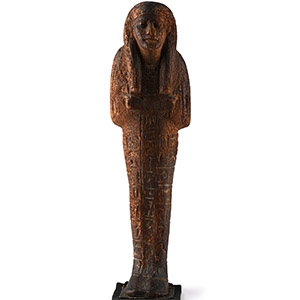
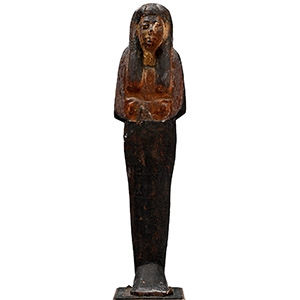
.jpg)
